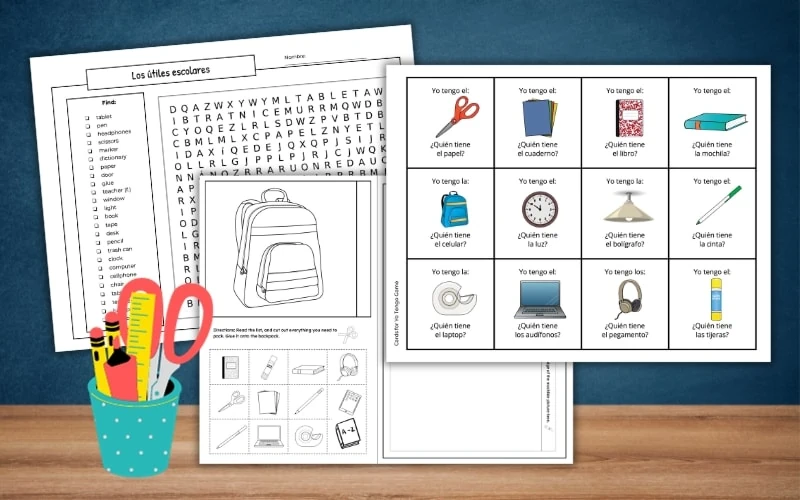The Best Way to Learn Spanish With a Native Speaker: 7 Tips
Inside: Tips for learning Spanish with a native speaker.
I’ve had several questions lately about children trying to practice Spanish with a native speaker (usually a family member). Families realize they have a great asset in the native speaker, but aren’t sure where to start. I often write about raising bilingual kids, but today I’d like to focus on families who are trying to teach an additional language, one the parents might not be fluent in.
Families often have multilingual relatives or friends, and would like to take advantage of that, but… it’s harder than it looks. For the rest of the post, I’m going to use a hypothetical situation as our example. Let’s say there is a family whose grandmother speaks Spanish and English. Her daughter speaks a little Spanish, and the grandchildren speak little to none. The grandmother would like to speak Spanish with the grandchildren and help teach them.
So, one day Grandma calls up on Skype. And… she suddenly realizes she doesn’t know where to begin. Should she just immerse her grandchildren in Spanish, and trust they’ll pick it up? How can she maintain the relationship and teach them something? How can she make sure the kids don’t get frustrated and give up on communicating?
Here are 7 Tips to help you navigate the situation!
1. GO FOR COMPREHENSIBLE INPUT, NOT IMMERSION AS INPUT.
Immersion–just speaking the language without limiting speech– is great if you have massive amounts of time. If you can go spend every summer at Grandma’s, by all means go for immersion. In the situations we’re discussing though, you will have to be more intentional and use the time you have wisely. You will need to limit new vocabulary and focus on recycling, recycling, recycling the words they know.
Comprehensible Input (CI) is just that… input that is understandable. It’s language that’s comprehensible because of pictures, gestures, or because all the words are known. CI is actually the way people acquire language itself, so don’t worry about teaching grammar or having Grandma correct the kids. They need to receive rich, interesting, chunked language from her. Although some isolated vocabulary is okay (numbers, colors, food etc), phrases are even better (How are you?, My favorite food is pizza., etc.) Remind the native speaker as well to speak slowly and clearly.
2. BEGIN WITH INTERESTING, HIGH-FREQUENCY PHRASES AND TOPICS.
Start by learning and practicing phrases that are natural and interesting to your kids. Perhaps Grandma can begin the call every week by asking things like, What did you do this week? What was the best part? What was the worst part? If the children are beginners, they can begin with just isolated words: park, party, test. At a much more complex level in the language, it might later be, I played at the park with friends, I went to a party, and I had a test at school.
In fact, if you know she asks that every time, the kids can think about their week, look up the words they need and learn them before the conversation. They will also be more motivated talking about that than random words. Make sure grandma models how to say hello, good-bye, and questions like, Can you repeat that? or How do you say….?, in case they get stuck.
3. USE VISUALS AS NEEDED.
If your children are absolute beginners, they are going to run out of things to say really fast. Grandma is also going to be very limited! It may help to have something to look at together. Perhaps the kids can draw their weeks, and do their best to describe it. Because there’s a picture, Grandma can ask questions and help them find the words they need. She could also use a picture or an object and tell them about it.
Reading books over Skype could work, as long as they are appropriately simple. Repetitive books like Brown bear, brown bear work well, or perhaps something they know in English.
4. USE QUESTIONS.
It’s really best if most of the talking is done by the native speaker. After all, what your children primarily need is input. But you don’t want it to be a monologue, and Grandma needs to know if she’s being understood or not. Questions should be frequent, to check in with the kids and make sure they’re tracking. With beginners, low-pressure yes/no, and either/or questions might be all they can handle: Did you like the park? Was the test good or bad? Did the caterpillar eat an apple or an orange?
Language teachers also use circling to ask questions. If Grandma is reading a book Se Vende Gorras, she might ask, Did the monkeys steal his hat? Did lions steal his hat? Did monkeys steal his glasses? It may be helpful to learn interrogative words like who, what, and how, to ask and answer questions.
5. LEARN POEMS OR SONGS IN THE NATIVE LANGUAGE.
The advantage of learning poems or songs is that you can practice them between visits, perhaps online or on a CD. Make up little motions to accompany the poem or song and make it more comprehensible too. You might even ask Grandma if she’ll record some songs, poems, or read-alouds to use at home.
6. PLAY GAMES.
It can be exhausting to practice a new language, both for the learner and the native speaker. Take some of the pressure off by having some games you can pull out during the visit or call. Try some of these:
- Bingo. Send Grandma the word cards, or a list of them, and have the kids play against each other while she calls out the terms.
- Guess Who. Mail Grandma one board, and keep copies at home too. This is great for practicing yes/no questions!
- Slap-it. Put cut out copies vocabulary cards on a table, and make sure Grandma has a matching set of terms. Grandma calls out the words and the kids compete to slap the card first.
- 20 Questions. The kids can take turns thinking of something. Grandma asks yes/no questions trying to guess what it is.
7. BE SENSITIVE TO EVERYONE’S NEEDS
Like I said, language learning can be daunting. Start slow, and keep sessions short at the beginning. You don’t want Grandma to feel like she’s losing out relationally with her grandchildren, and to get burned out on teaching. You also don’t want your kids to get overwhelmed and shut down, either! You will want to have a regular schedule, both to stay consistent and have a boundary: we talk in Spanish to Grandma on Tuesday, and on regular phone calls we speak English.
Keep it fun and upbeat! You are giving an incredible gift to your kids. Make sure they feel the joy as well.
Like it? Pin it!








If someone wants to practice spanish, I can give you my mom’s skype. She’s 70 and will be happy to talk to other people and to help. Btw she doesn’t speak any english.